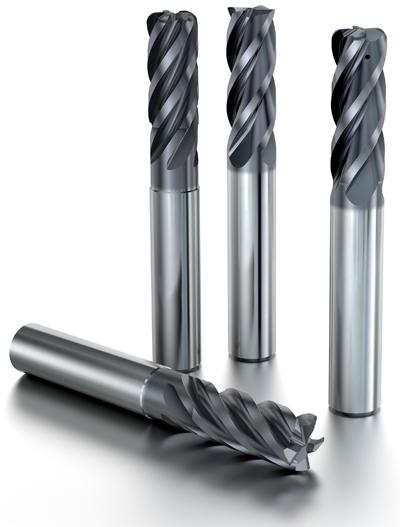
CoroMill Plura HD roughing end mill from Sandvik Coromant is for shoulder milling, full slot milling, and ramping and helical interpolation in steel and stainless steel. It can also be used with cast iron and heat-resistant materials. The tools offer secure and reliable machining in a wide range of cutting parameters.
High process security and long predictable tool life are essential in heavy roughing operations. CoroMill Plura HD's optimized flute shape was a result of the valuable insight gained from a Finite Element Analysis. The flute shape assures effective chip evacuation when machining a large depth of cut. The design also prevents re-cutting of chips and sudden tool breakage. By efficiently removing chips, full slot milling up to two times diameter with five-teeth end mills is possible without compromising process security. Internal coolant also promotes maximum chip evacuation and temperature control in stainless steel end mills.
The geometrical features and grades allow for exceptional metal removal rates and tool life. Two new grades have been developed; one for all-round conditions, preferably in dry machining, and one to deal with tough conditions and large engagements in wet machining. The tough face geometry was developed to cope with demanding ramping operations. Other features include differential pitch and cylindrical land to help minimize vibration and to provide predictable performance for reliable roughing.
Contact Details
Related Glossary Terms
- coolant
coolant
Fluid that reduces temperature buildup at the tool/workpiece interface during machining. Normally takes the form of a liquid such as soluble or chemical mixtures (semisynthetic, synthetic) but can be pressurized air or other gas. Because of water’s ability to absorb great quantities of heat, it is widely used as a coolant and vehicle for various cutting compounds, with the water-to-compound ratio varying with the machining task. See cutting fluid; semisynthetic cutting fluid; soluble-oil cutting fluid; synthetic cutting fluid.
- depth of cut
depth of cut
Distance between the bottom of the cut and the uncut surface of the workpiece, measured in a direction at right angles to the machined surface of the workpiece.
- gang cutting ( milling)
gang cutting ( milling)
Machining with several cutters mounted on a single arbor, generally for simultaneous cutting.
- interpolation
interpolation
Process of generating a sufficient number of positioning commands for the servomotors driving the machine tool so the path of the tool closely approximates the ideal path. See CNC, computer numerical control; NC, numerical control.
- land
land
Part of the tool body that remains after the flutes are cut.
- milling
milling
Machining operation in which metal or other material is removed by applying power to a rotating cutter. In vertical milling, the cutting tool is mounted vertically on the spindle. In horizontal milling, the cutting tool is mounted horizontally, either directly on the spindle or on an arbor. Horizontal milling is further broken down into conventional milling, where the cutter rotates opposite the direction of feed, or “up” into the workpiece; and climb milling, where the cutter rotates in the direction of feed, or “down” into the workpiece. Milling operations include plane or surface milling, endmilling, facemilling, angle milling, form milling and profiling.
- milling machine ( mill)
milling machine ( mill)
Runs endmills and arbor-mounted milling cutters. Features include a head with a spindle that drives the cutters; a column, knee and table that provide motion in the three Cartesian axes; and a base that supports the components and houses the cutting-fluid pump and reservoir. The work is mounted on the table and fed into the rotating cutter or endmill to accomplish the milling steps; vertical milling machines also feed endmills into the work by means of a spindle-mounted quill. Models range from small manual machines to big bed-type and duplex mills. All take one of three basic forms: vertical, horizontal or convertible horizontal/vertical. Vertical machines may be knee-type (the table is mounted on a knee that can be elevated) or bed-type (the table is securely supported and only moves horizontally). In general, horizontal machines are bigger and more powerful, while vertical machines are lighter but more versatile and easier to set up and operate.
- pitch
pitch
1. On a saw blade, the number of teeth per inch. 2. In threading, the number of threads per inch.

